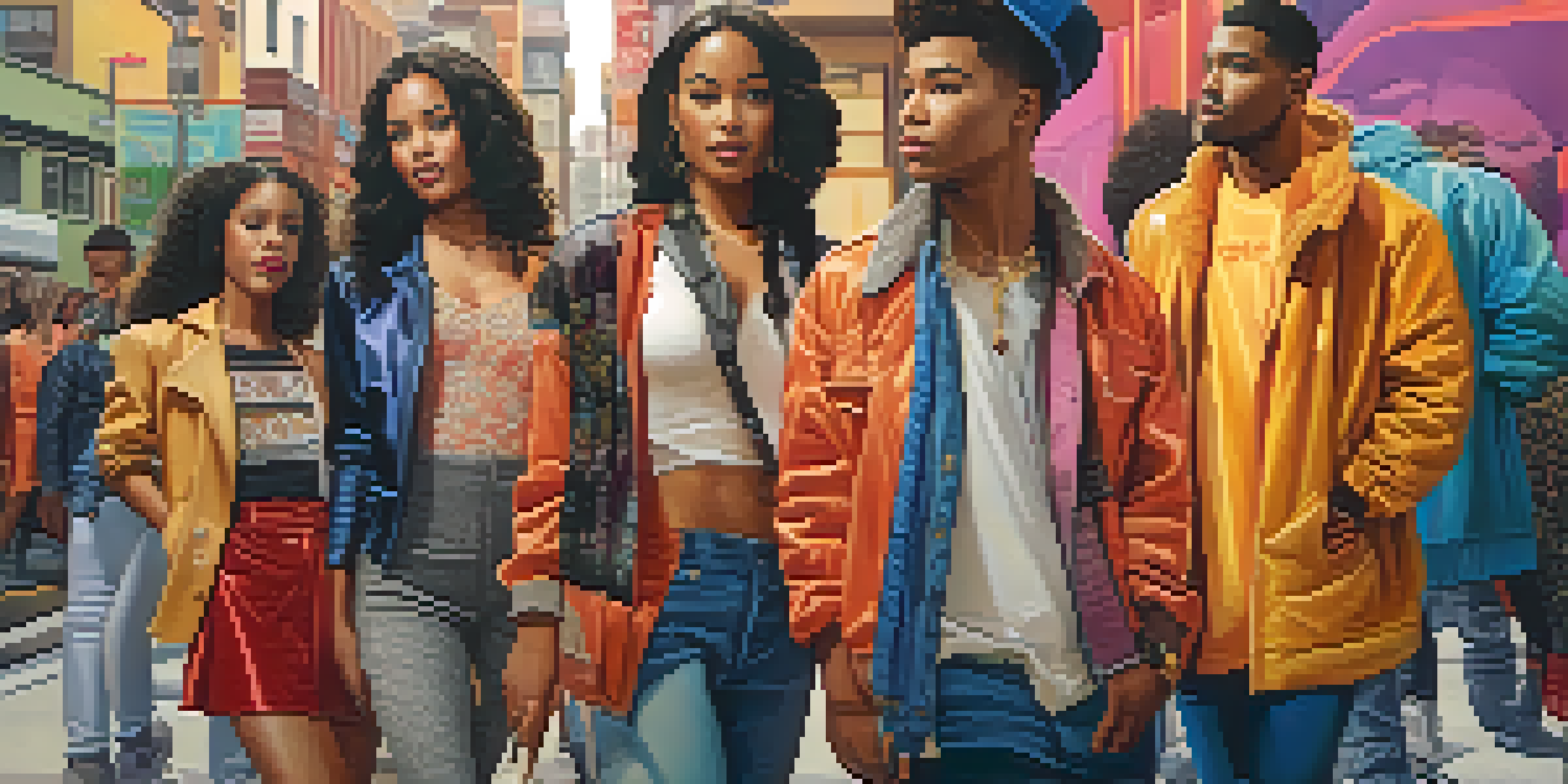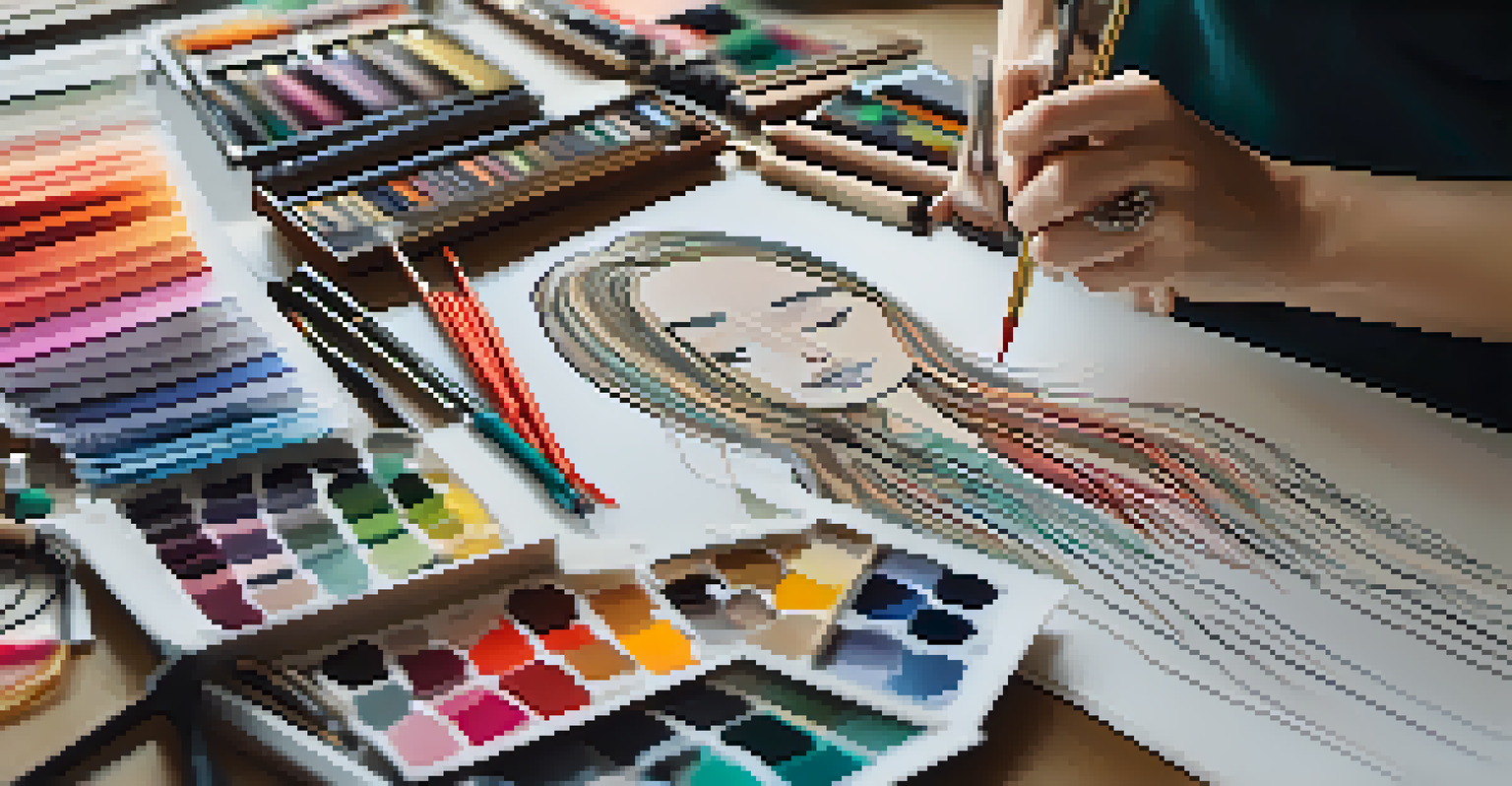The Connection Between Fashion and Body Image Issues

Fashion Trends and Societal Standards of Beauty
Fashion has the power to shape our perception of beauty, often dictating what is considered attractive. Trends can create unrealistic standards that many strive to achieve, leading to feelings of inadequacy. For instance, the rise of social media influencers has amplified certain body types, leaving others feeling excluded. This constant comparison can deeply impact self-esteem and body image.
Fashion is the armor to survive the reality of everyday life.
Moreover, the fashion industry frequently promotes a narrow definition of beauty, which can marginalize various body types. When only specific shapes and sizes are celebrated, it sends a message that anything outside of that norm is undesirable. This can lead to a cycle of negative body image, especially among young people who are still forming their self-identity.
Ultimately, the connection between fashion and body image is a complex one. While fashion can empower individuals to express themselves, it can also perpetuate harmful stereotypes. Recognizing this duality is essential for fostering a healthier relationship with our bodies.
The Impact of Fashion Advertising on Self-Perception
Fashion advertising plays a crucial role in shaping our views about body image. Advertisements often feature models who fit a specific ideal, subtly suggesting that this is the 'norm' everyone should aspire to. This can create a disconnect between reality and the images we see, making people feel as if they don't measure up. For many, this can lead to dissatisfaction with their own appearance.

Additionally, ads are often digitally altered, presenting a version of beauty that is unattainable for most. When consumers are constantly bombarded with these unrealistic images, it can foster a culture of comparison and self-criticism. This phenomenon can be particularly damaging for adolescents who are still developing their self-esteem.
Fashion Shapes Beauty Standards
Fashion trends often create unrealistic beauty standards, impacting self-esteem and body image.
As we navigate through a sea of fashion marketing, it's important to question the messages being conveyed. Awareness can help individuals cultivate a more positive self-image, breaking the cycle of negative self-perception driven by advertising.
Social Media's Role in Body Image and Fashion
Social media has transformed the fashion landscape, making trends more accessible but also more scrutinized. Platforms like Instagram and TikTok allow anyone to showcase their style, which can be empowering. However, these platforms also create an environment ripe for comparison, where likes and comments become a measure of worth. This can lead to intense pressure to conform to certain beauty standards.
Beauty begins the moment you decide to be yourself.
Influencers often showcase curated lifestyles that can influence followers' perceptions of beauty and body image. While some influencers promote body positivity, many still perpetuate narrow beauty ideals, leaving users feeling inadequate. It's essential to recognize the impact that these curated images can have on self-esteem and body image.
Ultimately, social media is a double-edged sword in the realm of fashion and body image. While it has the potential to foster community and inclusivity, it can also exacerbate feelings of inadequacy. Navigating this landscape with a critical eye is crucial for maintaining a healthy body image.
The Role of Body Positivity in Modern Fashion
The body positivity movement has gained significant traction in recent years, challenging traditional fashion norms. This movement advocates for the acceptance of all body types, promoting the idea that beauty comes in diverse forms. Many brands have begun to embrace this shift, featuring models of various sizes and shapes in their campaigns. This change is a step toward creating a more inclusive fashion industry.
However, the body positivity movement is not without its critiques. Some argue that it is often co-opted by brands for marketing purposes, diluting its original message. It's important to recognize genuine efforts to promote body diversity versus those merely hopping on the trend for profit. Transparency and authenticity are key components in supporting the movement.
Social Media Fuels Comparison
Social media platforms amplify beauty ideals, leading to a culture of comparison and pressure to conform.
As the fashion industry continues to evolve, the body positivity movement plays a critical role in reshaping perceptions of beauty. By promoting inclusivity, it encourages individuals to embrace their bodies, fostering a healthier relationship with fashion and self-image.
Fashion Choices and Personal Identity
Fashion is often a reflection of personal identity, allowing individuals to express who they are. The clothes we choose can convey our values, beliefs, and even our mood. However, societal pressures can sometimes dictate these choices, leading to a disconnect between personal style and external expectations. This struggle can impact how individuals view themselves and their bodies.
For many, aligning their fashion choices with their identity can be liberating and empowering. It allows for self-expression and can boost confidence. Conversely, those who feel pressured to conform may experience a sense of loss, struggling to define their individual style in a world of trends.
Ultimately, embracing fashion as a means of self-expression can foster a positive body image. When individuals feel free to dress in a way that resonates with their identity, it can help cultivate a sense of belonging and acceptance.
The Influence of Cultural Norms on Body Image
Cultural norms play a significant role in shaping perceptions of body image and beauty standards. Different cultures celebrate various body types, which can influence how individuals feel about their own bodies. For instance, in some cultures, fuller figures are seen as a sign of health and prosperity, while in others, slimness is idealized. This diversity highlights the subjective nature of beauty.
However, globalization and the rise of Western media can sometimes overshadow these cultural differences, imposing a more uniform standard of beauty. This can lead to feelings of inadequacy for those who don’t fit the dominant narrative. Understanding and appreciating cultural variations in beauty can promote a more inclusive approach to body image.
Body Positivity Advocates Diversity
The body positivity movement promotes the acceptance of diverse body types, challenging traditional fashion norms.
Recognizing the impact of cultural norms allows for a broader perspective on body image issues. By celebrating diverse standards of beauty, we can foster a more accepting environment for all body types.
Fashion's Role in Promoting Mental Health Awareness
The intersection of fashion and mental health is an emerging conversation within the industry. Many brands are recognizing the importance of mental well-being and are using their platforms to promote awareness. Fashion can serve as a form of therapy for some, allowing individuals to express emotions and boost their self-esteem through their style choices. This positive approach can help combat body image issues.
Moreover, campaigns that focus on mental health can de-stigmatize conversations around body image and self-acceptance. By promoting messages of love and acceptance, the fashion industry can contribute to a healthier dialogue surrounding mental well-being. This shift is crucial in supporting individuals struggling with body image issues.

Ultimately, fashion has the potential to be a powerful tool for promoting mental health awareness. By fostering an environment of acceptance and self-expression, the industry can help individuals cultivate a more positive body image.